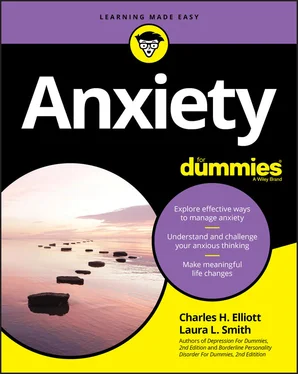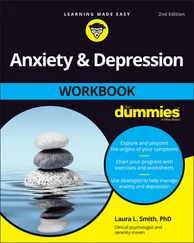Laura L. Smith - Anxiety For Dummies
Здесь есть возможность читать онлайн «Laura L. Smith - Anxiety For Dummies» — ознакомительный отрывок электронной книги совершенно бесплатно, а после прочтения отрывка купить полную версию. В некоторых случаях можно слушать аудио, скачать через торрент в формате fb2 и присутствует краткое содержание. Жанр: unrecognised, на английском языке. Описание произведения, (предисловие) а так же отзывы посетителей доступны на портале библиотеки ЛибКат.
- Название:Anxiety For Dummies
- Автор:
- Жанр:
- Год:неизвестен
- ISBN:нет данных
- Рейтинг книги:5 / 5. Голосов: 1
-
Избранное:Добавить в избранное
- Отзывы:
-
Ваша оценка:
Anxiety For Dummies: краткое содержание, описание и аннотация
Предлагаем к чтению аннотацию, описание, краткое содержание или предисловие (зависит от того, что написал сам автор книги «Anxiety For Dummies»). Если вы не нашли необходимую информацию о книге — напишите в комментариях, мы постараемся отыскать её.
If you feel like your life is spinning out of control, you're definitely not alone! While anxiety is a natural reaction to stress, for some of us, it can become all-consuming—and ultimately debilitating. Thankfully, there is plenty you can do to combat anxiety with the help of this approachable guide. Inside, find out how adopting proven techniques like pinpointing triggers, improving health and eating habits, and learning to let go can help you effectively and deliberately manage your worries—and take back control of your life.
Recognize symptoms Know useful vs. toxic anxiety Examine the causes of your anxiety Develop the practice of mindful acceptance Help your kids with their anxiety Block the blues Face your fears Adopt anxiety-reducing habits

 One other therapy you may hear about is called cognitive behavior therapy (CBT), which essentially represents a combination of CT and BT. We write about these specific types of therapies to inform our readers about what research has found to be successful. In general, all these approaches seem to work. Many of the techniques in each therapy are similar and overlap. That fact may explain why outcome studies have not demonstrated clear superiority for one of these approaches over the others.
One other therapy you may hear about is called cognitive behavior therapy (CBT), which essentially represents a combination of CT and BT. We write about these specific types of therapies to inform our readers about what research has found to be successful. In general, all these approaches seem to work. Many of the techniques in each therapy are similar and overlap. That fact may explain why outcome studies have not demonstrated clear superiority for one of these approaches over the others. Treatments that work share similar strategies. Therefore, we select some of the best elements from each type of therapy for dealing with common symptoms of anxiety, as seen in Part 2.
Treatments that work share similar strategies. Therefore, we select some of the best elements from each type of therapy for dealing with common symptoms of anxiety, as seen in Part 2. You should feel comfortable talking with your therapist. After a few sessions, you should feel listened to and understood and sense that your therapist has legitimate empathy and concern for your well-being. Don’t hesitate to inquire about the nature of your treatment plan — that plan should make sense to you. Most therapists take a few weeks getting to know you before they formulate an entire plan. If you’re uncomfortable for any reason, by all means seek a second opinion from another therapist. Research shows that how you feel about the relationship with your therapist makes a big difference in how well the therapy goes.
You should feel comfortable talking with your therapist. After a few sessions, you should feel listened to and understood and sense that your therapist has legitimate empathy and concern for your well-being. Don’t hesitate to inquire about the nature of your treatment plan — that plan should make sense to you. Most therapists take a few weeks getting to know you before they formulate an entire plan. If you’re uncomfortable for any reason, by all means seek a second opinion from another therapist. Research shows that how you feel about the relationship with your therapist makes a big difference in how well the therapy goes.










